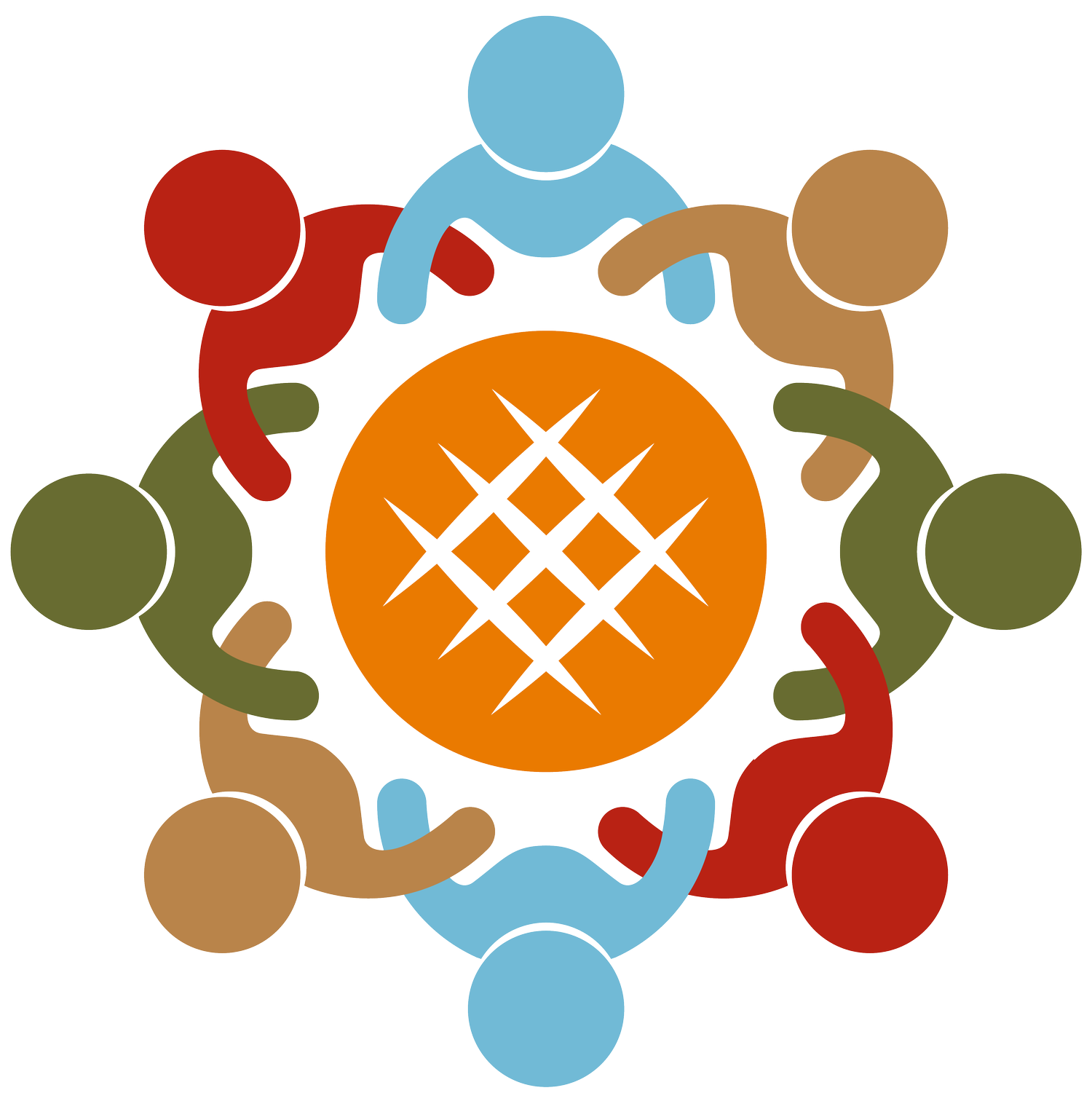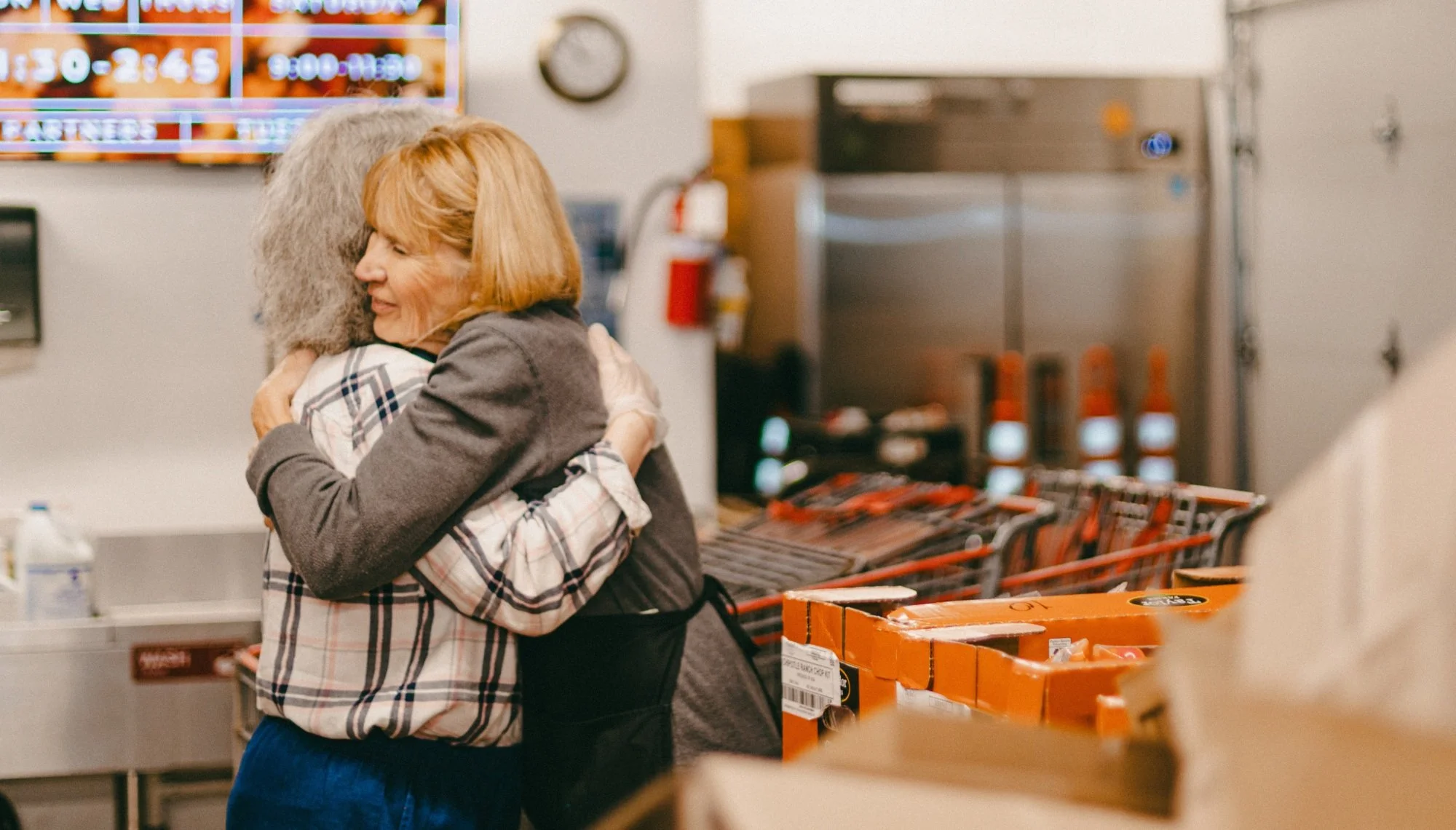Abundance Through Relationships
A heartfelt embrace at the Puyallup Food Bank between volunteers
How the Puyallup Food Bank Moves $20M in Food Annually—Without Buying It
Imagine a food bank that moves nearly $20 million in retail value worth of food annually—without spending a single dime on food purchases. This isn't a magic trick or a miracle. It's the lived reality of our work at the Puyallup Food Bank, where we've discovered that relationships are the most powerful currency in addressing food insecurity.
We began our journey as a small food pantry in a local church. Rooted in a Christian ethos of neighbors helping neighbors, we grew to become one of the largest food banks in Pierce County. From this heritage emerged the simple yet radical question: What if food scarcity is more about disconnection than actual shortage? Most food relief organizations tend to focus on the deficit. But in Pierce County, roughly 1.4 billion pounds of food move through our ecosystem each year. Those who are aware of the waste created by our large fragile food system may perhaps see this as an overwhelming challenge. We see it as an opportunity—a complex logistical puzzle waiting to be solved through intentional connection.
The traditional model of food banking often operates from a place of scarcity. Buy what you can. Stretch every dollar. Manage limited resources. We've chosen a different path—not to replace or undermine normal food purchasing practices, but to demonstrates that there is another way—one rooted in trust, collaboration, and the belief that our community already possesses incredible abundance and generosity, if only we knew how to unlock it.
The Right to Food and the Power of Relationship
The United Nations Food and Agriculture Organization states, “The right to food is not a right to be fed, but primarily the right to feed oneself in dignity.” Charity, when one-sided and impersonal, can reinforce a cycle of dependency. Most individuals do not simply want to receive; they desire to contribute and participate in a community where they are both valued and valuable.
Author and theologian, Timothy Keller once wrote, “To be loved but not known is comforting but superficial. To be known and not loved is our greatest fear. But to be fully known and truly loved is, well, a lot like being loved by God. It is what we need more than anything.” This resonates deeply with us at PFB, where many volunteers and even staff have come from the food bank line ourselves, and over half of our current clients express an interest in donating or volunteering. We welcome them as equal partners in our work because we believe that no person or community should live in perpetual dependence. While temporary crises require emergency relief, long-term food insecurity in a community is a symptom of deeper systemic issues—a breakdown of community, disconnection, and underutilized resources.
A Different Narrative
What if we embraced a new vision—one where connection and reciprocity were the foundation of our food system? What if food banks actually invested tangibly in the belief that food was not scarce, but abundant? What if we built a system that gets people out of the food bank line, instead of counting on them to return again and again—as if “customer retention” were an applicable success metric for a food pantry? Many in our industry talk of “abundance” in their marketing campaigns, but how often does it tangibly inform their operating budget? Our experience at PFB tells us that tangible investments the support healthful relationships are the key to making this vision a reality.
It may surprise you to learn that PFB does not see itself primarily as a hunger relief organization, though we do certainly relieve hunger. While distributing food is at our core, we are better characterized as a holistic, relational poverty alleviation organization—where “food is the first step.” Food distribution is a key part of our method—it is not our core purpose. The "relational" aspect of this model is essential. It is through intentional partnerships with over 40 grocery stores, warehouses, logistics companies, truckers, and dock managers that we have maintained a steady flow of high-quality food without making a single food purchase since 2021. The Washington State Fair and Komo 4 have also facilitated 50,000lb food drives every year. These relationships, and others across multiple sectors, have taken years to develop, and some have lasted decades. Since 1972, the Puyallup Food Bank has nurtured all types of partnerships by simply being available and reliable. Over the last four years, this has resulted in100% retention of grocery partners. Our Rotary Club-funded refrigerated box truck delivers an exceptional return from these partners—often hauling up to $493,000 worth of food (roughly eight times its value) in a single week! What's more, though many food banks in our region work with grocery stores like we do, there are still windfalls of food and seasonal surges in available products which far outstrip the capacity of any one organization to respond to adequately. This is exactly where partnerships among food assistance organizations become essential.
The power of this collaborative approach is demonstrated in our partnership with Sumner Community Food Bank and other food banks in our area. When a local grocery store or a cold storage warehouse suddenly has a large surplus of perishable goods, we don’t compete—we collaborate. By working together, we ensure that food is distributed quickly and efficiently, reducing waste while maximizing impact. This is abundance in action—seeing resources not as limited, but as interconnected.
The Speed of Trust
Over the past few months, our team has been reading The Speed of Trust by Stephen Covey. Covey outlines how trust accelerates relationships, increasing efficiency and effectiveness—not just between individuals but also between organizations. We applaud the food pantries who work hard at building trust with the people they serve. But what about building trust with industry professionals—those tasked with managing the avalanche of fresh, refrigerated and frozen food which flows down I-5 on a daily basis? These unsung heroes have significant influence over whether food ends up in grocery stores, landfills, or food banks.
At PFB, we value these relationships because they are critical to grocery rescue operations nationwide. Repurposing food waste from grocery stores to feed hungry families was a standard practice of food banks and food pantries long before it rose to the level of national awareness in the last 15 years. With increased public engagement, grocery rescue continues to be a critical strategy. However, it is how we implement this locally that makes all the difference in the world. Trust is built with those on the ground by answering their call, showing up on time, and repeatedly demonstrating the ability to get things done. By applying Covey’s principles—integrity, respect, accountability, and keeping commitments—we have built relationships that unlock the abundance already present in our community.
Caveats and a Call to Collaboration
During a 2024 meeting with Pierce County food bank leaders, I shared our $0 food purchasing budget. The room fell silent before someone remarked, “That’s nice for Puyallup, but we don’t have those resources in our city. We have to buy food.”
It is true that some communities have fewer grocery stores, some food pantries have lower capacity for storage and transportation, and some funders are reluctant to divert food-purchasing dollars to the less glamorous infrastructure expenses necessary to support grocery rescue efforts. It is also true that the Puyallup Food Bank may indeed purchase food in the future—in fact, we hope to partner with local farms for this very purpose. And even with strong industry partnerships, shelf stable food is one category which often remains difficult to procure. However, this is where the narrative matters most. Rather than seeing scarcity as an inevitable challenge or an insurmountable obstacle, what if we worked together to create abundance for ourselves and our neighbors? What if we started with the assumption that we already have all we need right here in our town to make abundance a reality? Instead of competing for limited resources, what if we built collaborative networks to maximize what is already available?
Our success relies on sophisticated logistics and even more sophisticated relationship-building. This takes time, talent, and strategic investment. We've invested in technologies and infrastructure, like refrigerated storage, vehicles, and more, that allow us to move quickly, coordinate efficiently, and respond with agility when food becomes available. But our greatest technology is still human—it’s the network of trust we've carefully cultivated across multiple sectors.
Abundance, we've discovered, is more than just a marketing campaign slogan. It is something you can actually uncover right in your backyard. It’s something you can cultivate in your community, starting from right where you are. By providing relief, serving generously and insisting on the gift of hope, we work to cultivate abundance—conversation by conversation, connection by connection.
At PFB, we have seen firsthand that abundance is not about luck—it is about relationships. We believe that when communities come together, food insecurity can be addressed in a way that restores dignity, fosters connection, and builds resilience.
So let’s rethink the way we approach hunger relief. Let’s invest in relationships, trust, and collaboration. Because when we do, we will find that abundance was here all along, waiting to be unlocked.
By North Cady | Director of Programs and Grants at the Puyallup Food Bank


